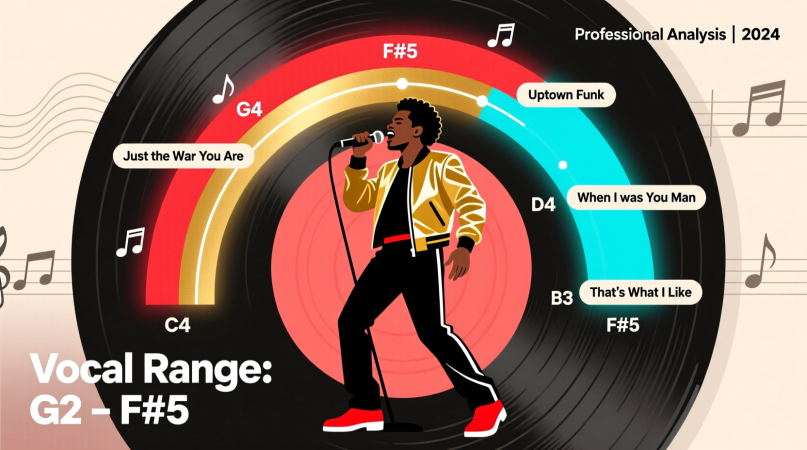
Bruno Mars is one of the most versatile performers of his generation. From silky ballads to funky dance tracks, his voice adapts seamlessly across styles. But what exactly is Bruno Mars’s vocal range, and how does it compare to other singers?
In this guide, we’ll break down the facts, clear up the myths, and explore what makes his voice so special.
What Do We Mean by Vocal Range?
Your vocal range is the distance between the lowest and highest notes you can sing.
- Average untrained singers cover 1.5 to 2 octaves.
- Professional singers usually manage 3 to 4 octaves.
- Exceptional vocalists may push beyond 4 octaves.
Bruno Mars falls into the professional category, with a widely accepted range that sits around three octaves.
Common Claims About Bruno Mars’s Vocal Range
Different sources give different measurements. Here are some of the most cited:
- SingingCarrots database: G♯2 – A5 (≈3.1 octaves).
- School of Rock listing: C3 – D5 – C6.
- VocalView analysis: C3 – D5 – C6, classifying him as a light-lyric tenor.
- Range Planet (fan forum): B♭2 – B5 (≈3 octaves).
- Wikipedia (Voice section): Notes that he is regarded as a tenor with a three-octave range.
The consensus is clear: Bruno Mars’s range comfortably covers at least three octaves, though the exact boundaries depend on whether rare notes or falsetto are counted.
Why the Numbers Differ
The variation comes down to how vocal range is measured:
- Studio vs. Live
- Studio recordings sometimes capture rare takes or layered harmonies.
- Live performances stick closer to his usable range.
- Falsetto vs. Chest Voice
- Some analyses include falsetto or head voice, while others focus on chest voice only.
- Usable vs. Extreme Notes
- A singer’s “usable range” (notes they consistently perform) is narrower than the extremes they can technically hit.
Bruno Mars’s Lowest Notes
Bruno’s low register is often overlooked, but he has hit some impressive lows:
- G♯2 – Documented in some live performances.
- B♭2 – Fan-confirmed in recordings.
- C3 / D3 – Frequently heard in songs like Grenade and Talking to the Moon.
While he doesn’t lean heavily on deep notes, his lows are rich and controlled.
Bruno Mars’s Highest Notes
Bruno’s high register is what often draws attention. He can sustain notes in the fifth octave with surprising ease:
- A5 – Reported in live improvisations.
- C6 – Cited in School of Rock and VocalView analyses.
- Falsetto peaks – Featured in Treasure and Marry You.
Unlike many singers, Bruno makes these highs sound effortless, often mixing falsetto with chest for power.
Bruno Mars’s Range in Numbers
Here’s a simple breakdown of his documented range:
| Note | Frequency (Hz) | Example Song |
|---|---|---|
| G♯2 | ~103 Hz | Live performances, rare lows |
| B♭2 | ~116 Hz | Fan-confirmed recordings |
| C3 | 130 Hz | Grenade verses |
| D5 | 587 Hz | Marry You chorus |
| A5 | 880 Hz | Live improvisations |
| C6 | 1046 Hz | Studio claims, falsetto lines |
That gives him roughly G♯2 to C6 — about three octaves.
Bruno Mars’s Voice Type: Light-Lyric Tenor
Most vocal coaches classify Bruno Mars as a light-lyric tenor.
- Tessitura: His sweet spot is around C3 – D5, where his voice sounds most natural.
- Falsetto: He uses falsetto frequently, especially in ballads.
- Tone: Bright, agile, and well-suited for pop, funk, and R&B.
For comparison, you can explore how tenors differ from sopranos in the soprano vocal range breakdown.
Songs That Showcase His Range
Bruno’s range isn’t just theory — it shows up across his hits:
- “Just the Way You Are” – F3 to C5
- “Marry You” – C4 to D5
- “Treasure” – B3 to E5
- “Gorilla” – B3 to A5
- “Talking to the Moon” – Low C3 to high falsettos
These songs highlight his ability to move seamlessly from warm lows to soaring highs.
How Bruno Mars Compares to Other Singers
| Singer | Range (approx.) | Voice Type |
|---|---|---|
| Bruno Mars | G♯2 – C6 (~3 octaves) | Light-lyric tenor |
| Adele | B2 – C6 (~3 octaves) | Mezzo-soprano |
| Freddie Mercury | F2 – E6 (~3.5 octaves) | Tenor/Baritone |
| Whitney Houston | C3 – C6 (~3 octaves) | Soprano |
| Mariah Carey | B2 – G7 (~5 octaves) | Soprano |
Bruno may not match Mariah Carey’s whistle notes, but his combination of agility, tone, and stylistic versatility sets him apart.
Myths About Bruno Mars’s Vocal Range
- “He has four octaves.”
➝ No credible evidence supports this; most sources agree on three. - “He’s a baritone.”
➝ While his lows are solid, his tessitura and tone fit a tenor. - “His range is shrinking.”
➝ His voice has matured, but he continues to perform challenging songs live.
Why Bruno Mars’s Voice Stands Out
Bruno’s success isn’t just about range — it’s about how he uses it.
- Stylistic versatility – Funk, soul, pop, R&B, and ballads.
- Control – Smooth transitions between chest, head voice, and falsetto.
- Performance charisma – His live delivery adds power beyond the studio.
- Consistency – Maintains vocal quality across tours and high-energy shows.
FAQs About Bruno Mars’s Vocal Range
What is Bruno Mars’s vocal range?
Most credible sources place it at G♯2 to C6 (~3 octaves).
What is his lowest note?
Around G♯2 / B♭2, though his consistent low range is C3.
What is his highest note?
He has sung up to C6, often in falsetto.
What voice type is Bruno Mars?
He’s generally classified as a light-lyric tenor.
Which songs show his range best?
Gorilla, Treasure, Marry You, Talking to the Moon, and Just the Way You Are.
Does he have four octaves?
No. Most reliable evidence supports about three.
